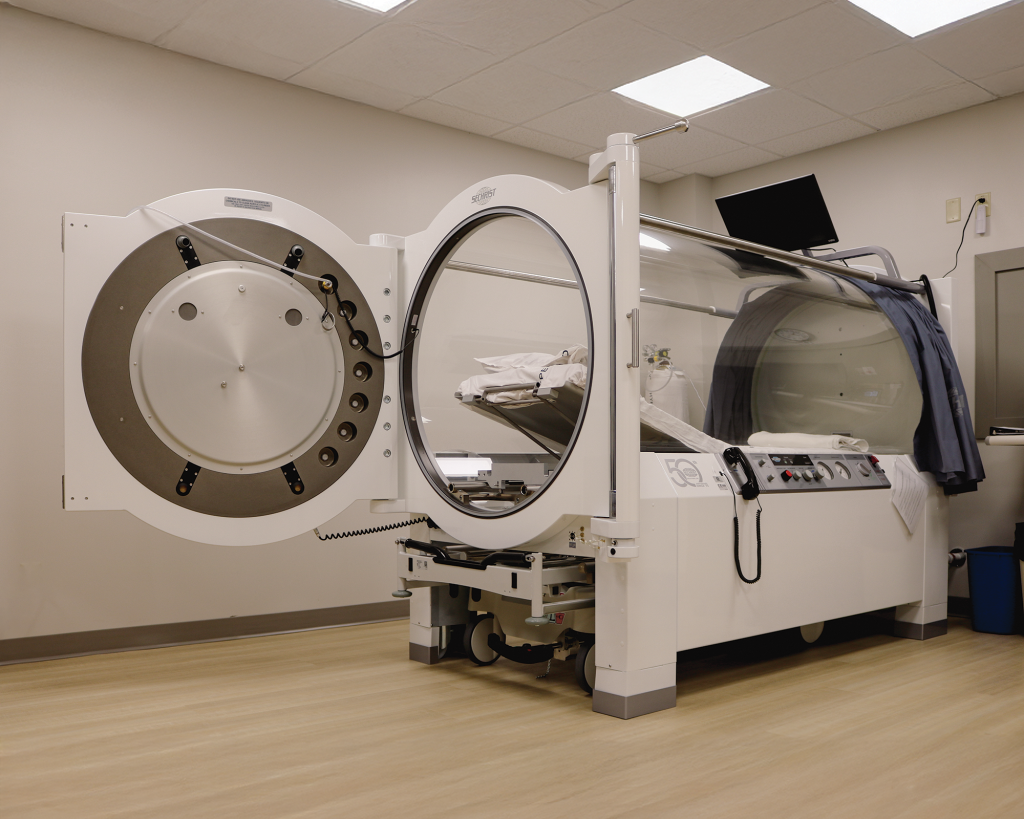Hyperbaric chambers are fascinating pieces of medical equipment used to deliver oxygen therapy in a pressurized environment. They help treat various conditions. The chamber allows patients to breathe pure oxygen at higher-than-normal atmospheric pressure. This process can speed up healing, fight infections, and improve recovery for many health issues.
Two main types of chambers dominate the field: multiplace and monoplace hyperbaric chambers. Today, we will explore what these chambers are. Let’s find out how they differ, their uses, and other related options like decompression chambers. By the end, you’ll know the types of chambers available and which might suit specific needs.
What Is a Multiplace Hyperbaric Chamber?
A multiplace hyperbaric chamber is a large, room-like structure designed to treat multiple patients at the same time. It’s built to accommodate several people, typically ranging from 2 to 12 or more. However, it always depends on the chamber’s size. These chambers are often found in hospitals or specialized medical facilities due to their size and complexity.
Inside a multiplace chamber, patients sit or lie down while breathing pure oxygen through masks, hoods, or tubes. The chamber is pressurized with regular air, and medical staff can enter to monitor or assist patients during treatment. This setup makes it ideal for situations where close supervision is needed. For example, critically ill patients or those requiring complex treatments.
Some key features of multiplace chambers include:
- Capacity. Can treat multiple patients at once, making it efficient for busy facilities.
- Medical Staff Access. Doctors or nurses can enter the chamber to provide hands-on care.
- Versatility. Suitable for a wide range of conditions, from severe wounds to decompression sickness.
- Comfort. Patients can interact with others, which helps reduce anxiety during long sessions.
Multiplace chambers are often used for conditions like carbon monoxide poisoning, severe infections, or chronic wounds that don’t heal easily. They’re also common in diving medicine, where divers with decompression sickness are usually treated.
What Is a Monoplace Hyperbaric Chamber?
A monoplace hyperbaric chamber is a smaller, single-person chamber designed for individual treatment. It looks like a long, cylindrical tube, often made with clear acrylic so patients can see outside. This reduces feelings of claustrophobia. These chambers are pressurized with 100% pure oxygen, so patients breathe the therapeutic gas directly without needing a mask.
Monoplace chambers are simpler to operate than multiplace ones and are often found in smaller clinics, outpatient centers, or even private practices. They’re ideal for patients who need regular treatments and usually don’t need intensive medical supervision during sessions.
Key features of monoplace hyperbaric chambers include:
- Single-Person Use. Designed for one patient at a time, offering a private experience.
- Ease of Use. Simpler setup and operation, requiring less staff training.
- Compact Size. Fits in smaller spaces, making it accessible for smaller facilities.
- Comfort Features. Often has entertainment options like TVs or music to keep patients relaxed.
Monoplace chambers are commonly used for conditions like diabetic foot ulcers, radiation injuries, or mild infections. They’re also popular for wellness treatments. However, these uses are less medically established.
Monoplace vs. Multiplace Chamber – Critical Comparison

When choosing between a multiplace chamber and a monoplace chamber, several factors come into play. Each has its strengths and weaknesses, depending on the patient’s needs, the facility’s resources, and the condition being treated. Let’s break down the critical differences:
- Capacity. A multiplace hyperbaric chamber (another term for multi-person chamber) can treat several people at once. This makes it ideal for hospitals with high patient volumes. In contrast, a monoplace chamber treats only one person per session, which suits smaller clinics or individual-focused care.
- Pressurization Method. In a multiplace chamber, the entire room is pressurized with air, and patients breathe oxygen through delivery systems like masks. Monoplace chambers are filled with pure oxygen, so no extra equipment is needed for breathing.
- Medical Supervision. Multiplace hyperbaric chambers allow medical staff to be inside during treatment. This is crucial for patients who need constant monitoring or emergency care. Monoplace chambers don’t allow staff inside during sessions, so any assistance must be provided before or after.
- Cost and Maintenance. A multiplace hyperbaric chamber is more expensive to install and maintain due to its size and complexity. Monoplace chambers are generally more affordable and easier to maintain, making them appealing for smaller facilities.
- Patient Experience. Multiplace chambers allow patients to interact with others, which can be comforting for long treatments. Monoplace chambers offer privacy but may feel isolating for some patients. However, features like clear walls and entertainment systems help.
- Treatment Flexibility. Multiplace chambers can handle a broader range of conditions, including emergencies, due to their ability to accommodate medical staff and equipment. Monoplace chambers are better suited for routine or less severe cases.
For example, a hospital treating a diver with decompression sickness might prefer a multiplace chamber for its ability to provide immediate medical support. On the other hand, a clinic treating a patient with a chronic wound might opt for a monoplace chamber for its simplicity and lower cost.
Other Types of Decompression Chambers
Beyond hyperbaric chambers used for medical therapy, decompression chambers serve a specific purpose, primarily in diving and aerospace. These chambers are designed to help individuals transition safely from high-pressure environments (like deep-sea diving) to normal atmospheric pressure. This prevents conditions like decompression sickness, also known as “the bends.”
Decompression chambers work similarly to hyperbaric ones, but they’re tailored for specific scenarios:
- Diving Decompression Chambers. Used by divers who ascend too quickly from deep water, causing nitrogen bubbles to form in their blood. These chambers gradually reduce pressure to allow safe decompression.
- Portable Decompression Chambers. Smaller, lightweight versions used in remote diving locations or on ships. They’re designed for emergency use and can stabilize a diver until they reach a larger facility.
- Aerospace Decompression Chambers. Used to simulate high-altitude conditions for pilots or astronauts, helping them train for low-pressure environments or treat altitude-related illnesses.
These decompression chambers share technology with hyperbaric ones, but their primary focus is on pressure regulation rather than oxygen therapy. They’re critical in fields where rapid pressure changes are common, ensuring safety and preventing serious health risks.
Types Of Hyperbaric Chambers To Choose From
When deciding on the right tool, it’s essential to understand the types of hyperbaric chambers available and their uses. Here’s a quick guide to help you choose:
Multiplace Hyperbaric Chambers:
- Best for. Hospitals, large medical centers, or emergency treatments
- Ideal conditions. Decompression sickness, severe infections, carbon monoxide poisoning, complex wound care
- Pros. Treats multiple patients, allows medical staff inside, versatile for critical cases
- Cons. Expensive, requires more space and trained staff
Monoplace Hyperbaric Chambers:
- Best for. Outpatient clinics, private practices, or wellness centers
- Ideal conditions. Chronic wounds, radiation injuries, mild infections, some wellness uses
- Pros. Affordable, compact, easy to operate, private for patients
- Cons. Limited to one patient, no in-session medical supervision
Portable Hyperbaric Chambers:
- Best for. Home use or small clinics (though medical supervision is still recommended)
- Ideal conditions. Mild conditions or wellness-focused treatments (not always FDA-approved for medical use)
- Pros. Lightweight, affordable, easy to set up
- Cons. Lower pressure levels, less regulated, not suitable for severe conditions
Decompression Chambers:
- Best for. Diving centers, aerospace training facilities, or emergency use in remote locations
- Ideal conditions. Decompression sickness, altitude-related issues
- Pros. Specialized for pressure regulation, portable options available
- Cons. Not designed for general medical oxygen therapy
Choosing the type of hyperbaric chamber depends on the patient’s condition, the facility’s resources, and the treatment goals. For serious medical conditions, always consult a healthcare provider to ensure the chamber is used safely and effectively.
In summary, hyperbaric chambers offer incredible benefits for healing and recovery. Multiplace chamber and monoplace chamber are the primary options for medical use. Multiplace chambers excel in treating multiple patients and complex cases, while monoplace chambers are ideal for individual, routine treatments. Other options, like decompression chambers, cater to specific needs in diving or aerospace.











